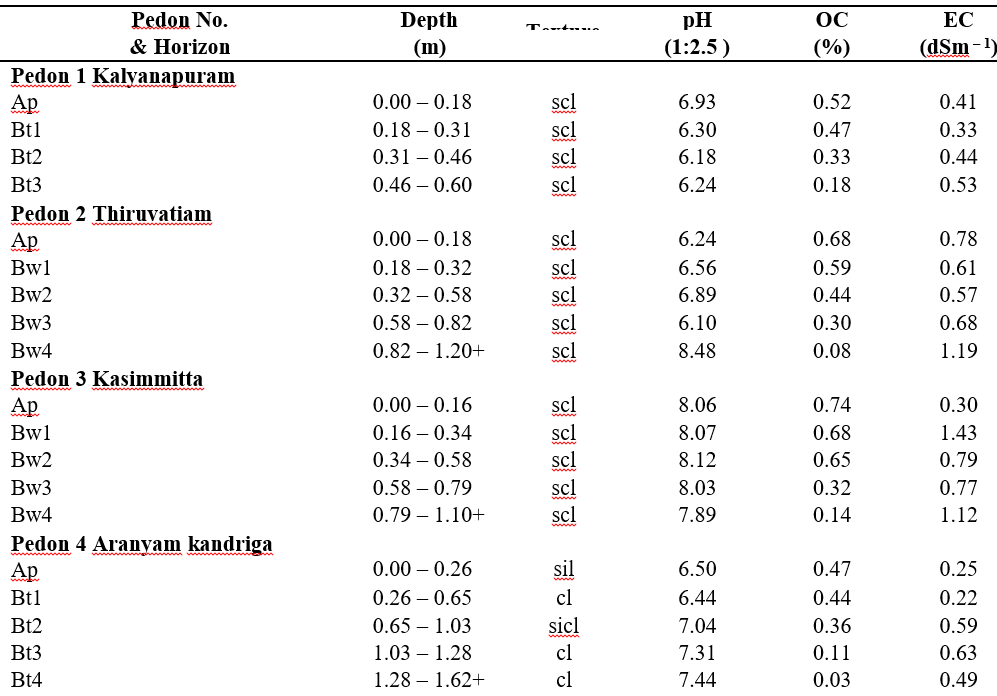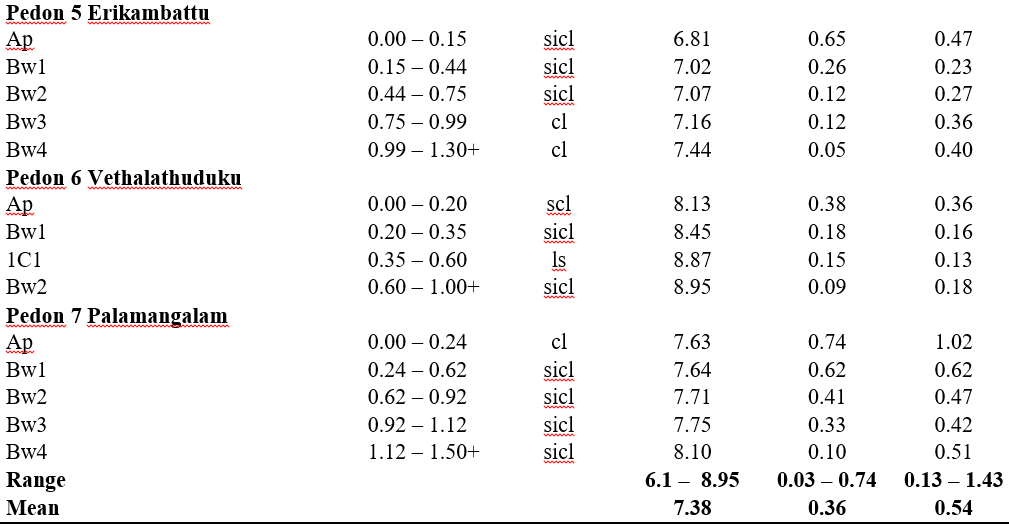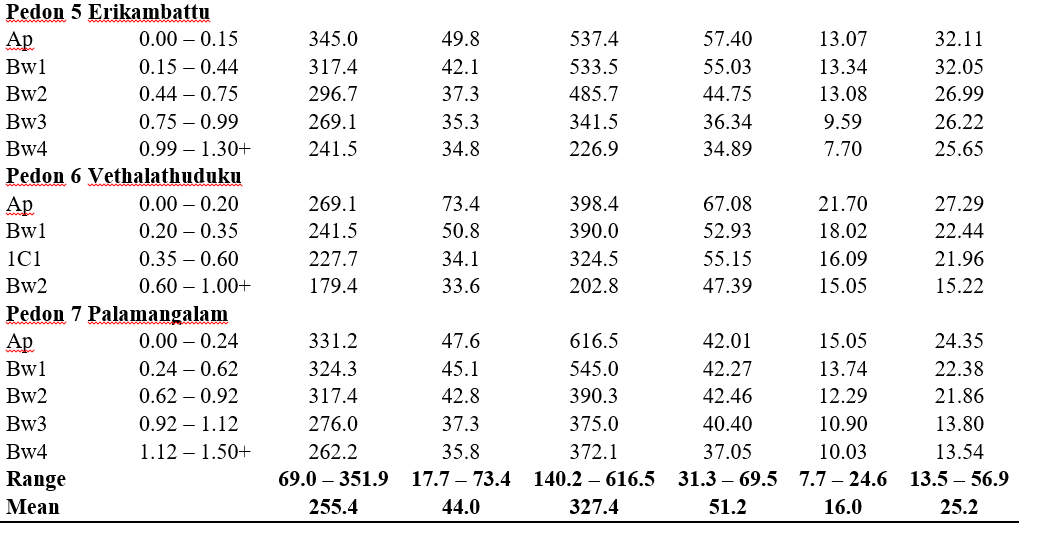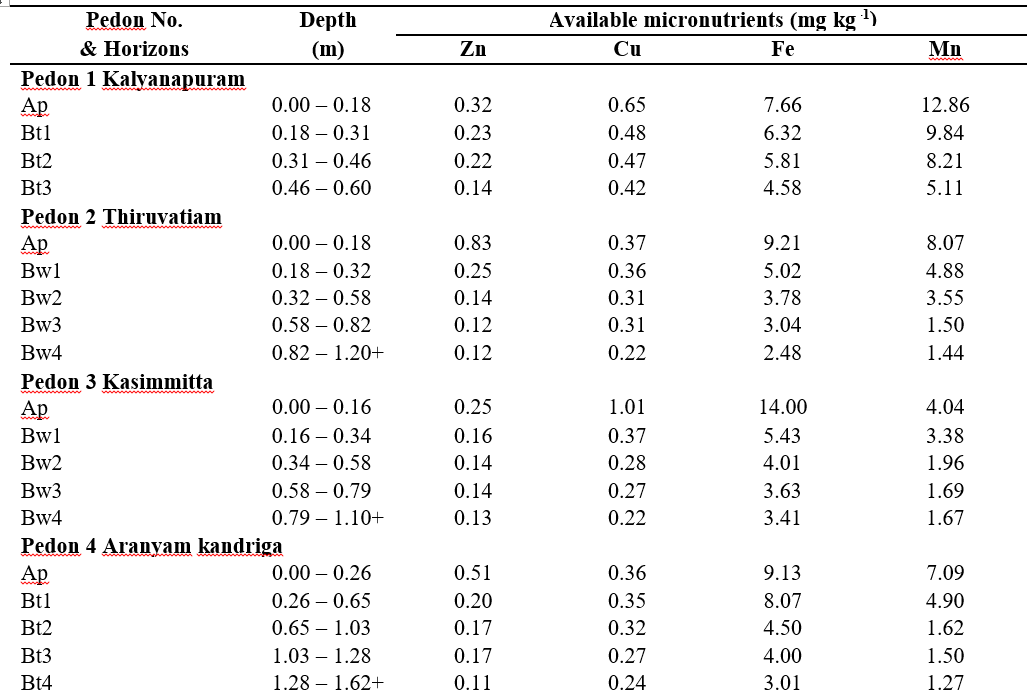Vertical Distribution of Nutrients in Groundnut Growing Soils in Narayanavanam Mandal of Chittoor District, Andhra Pradesh
0 Views
NILOFAR DOULAT SHAHI, M.V.S. NAIDU*, T. GIRIDHARA KRISHNA AND PRABHAKAR REDDY2
Professor and Head, Department of Soil Science and Agricultural Chemistry, S.V. Agricultural College, ANGRAU, Tirupati.
ABSTRACT
Soil survey was undertaken to study the vertical distribution of plant nutrients in the soil profiles / pedons in groundnut growing areas of Narayanavanam mandal of Chittoor district, Andhra Pradesh to understand nutrient supply capacity of soils. The soils were slightly acidic to strongly alkaline (6.10 to 8.95), non saline (0.13 to 1.43 dSm-1), low to medium in organic carbon (0.03 to 0.74%) and texture varied from loamy sand to clay loam. The available P and K, exchangeable Ca and Mg and available S were sufficient in surface and sub-surface soils of all the pedons. DTPA extractable Zn was found to be deficient in both surface and sub-surface soils of all the pedons. DTPA extractable Cu was sufficient in surface horizons of all the pedons except in pedons 2 and 4 whereas most of the sub-surface horizons all the pedons were deficient in Cu. The DTPA extractable Mn was sufficient in both surface and sub-surface horizons of pedons 1 and 5 whereas in the remaining pedons, it was sufficient in surface horizons and sufficient to deficient in sub-surface horizons. However, the DTPA extractable Fe was sufficient in surface and subsurface horizons of pedon 1 and sufficient in surface horizons and sufficient to deficient in sub-surface horizons of all the reaming pedons.
KEYWORDS: Groundnut, Macro and Micronutrients, Organic carbon, pH, Surface and Sub -surface soil.
INTRODUCTION
The vertical distributions of plant nutrients in soils is important for efficient nutrient management and for achieving sustainable yields (Leelavathy et al., 2021) as roots of most of the crops go beyond the surface layer and draw part of their nutrient requirement from the sub- surface layers of the soil. Most of the earlier researchers have limited their studies on nutrient status of surface soils only, but nutrient status of sub surface soils plays a key role for effective nutrient management. Hence, an attempt was made to study the nutrient status of sub surface soils. However, the detailed information regarding the vertical distribution of macro and micronutrient status in groundnut growing soils of Chittoor district in particular and Andhra Pradesh in general is very much lacking. Hence, present survey was conducted to study the depth wise distribution of nutrients in groundnut growing soils of Narayanavanam mandal of Chittoor district, Andhra Pradesh, as the groundnut is major crop in the area.
MATERIAL AND METHODS
Location and Agro-climate
Narayanavanam mandal of Chittoor district, Andhra Pradesh was spread over an area of 11,389 ha and lies in between 13° 25’to 13° 42’ of North latitude and 79° 35’ to 79° 58’ of East longitudes. The climate of the area is semi-arid monsoonic with distinct summer, winter and rainy seasons with a mean annual rainfall of 1170.86 mm, of which 92.05 per cent is received during May to December. The mean annual temperature is 28.37°C with mean summer temperature of 28.00°C and the mean winter temperature of 27.82°C. The maximum temperature was recorded in May that rises to 36.35°C and the minimum temperature is 26.19°C in December. The soil moisture regime is ustic and soil temperature regime is isohyperthermic.
Field survey and Taxonomic classification
Reconnaissance soil survey was conducted and s even typical pedons were arranged in the groundnut growing areas of Narayanavanam mandal of Chittoor district, Andhra Pradesh during 2020-21.The taxonomy of these seven pedons viz., Kalyanapuram, pedon 1 (P1- Fine -loamy, mixed, isohyperthermic, Typic Rhodustalfs), Thiruvatyam, pedon 2 (P2- Fine-loamy, smectitic, iso- hyperthermic, Dystric Haplustepts), Kasimmitta, pedon 3 (P3- Fine – loamy, smectitic, isohyperthermic, Typic Haplustalfs), Aranyamkandriga, pedon 4 (P4- Fine- loamy, mixed, isohyperthermic, Typic Haplustalfs), Erikambatt, pedon 5 (P5 – Fine-loamy, smectitic, isohyperthermic, Vertic Haplustepts),Vethalathaduku, pedon 6 (P6- Fine- loamy, smectitic, isohyperthermic, Fluventic Haplustepts) and Palamangalam,7 pedon 7 (P7- Fine, smectitic, isohyperthermic, Vertic Haplustepts). The horizon wise soil samples were collected for detailed analysis. The pedons P2, P5, P6 and P7 belongs to Inceptisols, P1, P3 and P4 were classified under Alfisols. The soil samples were processed and analyzed for pH, EC, organic carbon, texture available macro and micronutrients using standard methods as described by Jackson (1973).
The critical limits proposed by Patel and Savani (1987) for available P (13 kg P ha-1), Aulakh et al. (1988) for available K (150 kg K ha-1), Tandon (1991) for exchangeable Ca (1.5 cmol (p+) kg-1), Mg (1.0 cmol (p+) kg-1) and available S (10 mg kg -1), Anon (1977) for Zn (0.75 mg kg-1) and Tandon (1993) for Fe (4 mg kg-1), Cu (0.5 mg kg-1) and Mn (2 mg kg-1) were followed for classifying profile soil samples into sufficient or deficient for groundnut.
RESULTS AND DISCUSSION
pH, EC, OC and texture
The groundnut growing soils were slightly acidic to strongly alkaline in their reactivity (6.10 to 8.95) (Table 1) and this wide variation in pH was attributed to the nature of the parent material, leaching, presence of calcium carbonate, exchangeable sodium and the release of organic acids during decomposition of organic matter. Similar findings were reported by Leelavathy and Naidu (2020). The texture of the groundnut growing soils varied from loamy sand to clay loam and this textural variation was caused by topographic position, nature of parent material, in situ weathering and translocation of clay (Leelavathi et al., 2010). The EC in groundnut growing soils was ranged from 0.13 to1.19 dSm-1 indicating their non-saline nature (Table 1). The low EC of groundnut growing soils can be attributed to free drainage conditions which favoured the removal of released bases by percolation and drainage (Sashikala et al., 2019). The organic carbon
content of the groundnut growing soils was low to medium (0.03 to 0.74 per cent), which can be attributed to the prevalence of tropical condition, where the degradation of organic matter occurs at a faster rate coupled with low vegetative cover, thereby leaving less organic carbon in the soils (Supriya et al., 2019).
Macronutrients
The available N varied from 69.0 to 351.9 kg N ha-1 with a mean of 255.4 kg N ha-1 in all the pedons in groundnut growing areas indicating low to medium in nature (Table 2). The low available nitrogen in the soils may be due to semi arid climate of the area which might have favoured rapid oxidation and lesser accumulation of organic matter, releasing more NO3-N which could have been lost by leaching (Devi et al., 2015).
The available P varied from 17.7 to 73.4 kg P kg ha-1 in all horizons of the pedons of groundnut growing areas with a mean of 44 P kg ha-1 (Table 2). Considering 13 kg P ha-1 as critical level, the available P status was sufficient in the surface and sub-surface horizons of all the pedons except Bw4 horizon of pedons 2 and 3 and decreased with depth in all the pedons of groundnut growing areas, which might be due to the confinement of crop cultivation to the rhizosphere and supplementing the depleted P by external sources i.e., application of fertilizers to the surface soil (Purandhar and Naidu, 2020).
The available K of groundnut growing soils was varied from 140.2 to to 616.5 kg ha-1 with a mean value
327.4 kg ha-1 (Table 2). Taking 150 kg K ha-1 as a critical limit, both surface and sub-surface horizons of all the pedons were sufficient in available and showed a decreasing trend with depth. The higher available potassium could be attributed for greater weathering of the K bearing minerals, application of K fertilizers and upward translocation of K from lower depths along with capillary movement of ground water (Vedadri and Naidu, 2018).
The exchangeable Ca in groundnut growing soils was ranged from 31.3 to 69.5 cmol (p+) kg-1 soil with a mean of 51.2 cmol (p+) kg-1 soil. Similarly, the exchangeable Mg in groundnut growing areas was found to vary from
7.70 to 24.6 cmol (p+) kg-1 of soil with a mean of 16.0 cmol(p+) kg-1 of soil (Table 2). Taking 1.5 cmol (p+) kg- 1 of soil for Ca and Mg as critical limit, the exchangeable Ca and Mg were well above their critical limits and found sufficient for crop growth. The exchangeable Ca was
Table 1. Physico–chemical properties of soils of Narayanavanam village of Chittor district


found to be the dominant cation followed by Mg because of its higher mobility, earlier removal than the Mg and also Ca dominates in the prevailing semi-arid weathering environment and consequently occupied the major portion on the exchange complex in the groundnut growing soils (Reddy and Naidu, 2016).
The available S in groundnut growing soils varied from 13.54 to 56.92 mg kg-1 with a mean of 25.2 mg kg- 1 (Table 2). Taking 10 mg S kg-1 soil as critical value, the available S was sufficient in surface and subsurface horizons of all the pedons of groundnut growing areas. The higher available sulphur may be due to higher amount of organic matter in surface layers than in sub-surface layers. Similar findings were reported by Devi et al. (2015).
Micronutrients
The available Zn content in the soil profiles of groundnut growing areas varied from 0.07 mg kg-1 to 0.83 mg kg-1 with a mean of 0.22 mg kg-1 (Table 3). Further, by taking 0.75 mg Zn kg-1 soil as critical limit, the available Zn found to be deficient in both surface and sub-surface soils of all the pedons. The deficiency of Zn was ascribed to low amount of organic carbon in these soils, which was confirmed by significant and positively correlation (r =+0.340) of Zn with organic carbon. Similar findings were reported by Sireesha and Naidu (2013).
The available Fe status in all the pedons of groundnut growing areas was found to be varied from 1.46 and 14.00 mg kg-1 soil with a mean of 4.69 mg kg-1 soil (Table 3). As per the critical limit of 4.0 mg kg-1 soil, the DTPA extractable Fe in groundnut growing areas was sufficient in surface and subsurface horizons of pedon 1 and sufficient in surface horizons of remaining pedons and sufficient to deficient in sub-surface horizons of most of the pedons. The sufficiency of Fe in surface horizons might be due to accumulation of organic carbon and prevalence of reduced conditions in the surface horizons. The organic carbon influence the solubility and availability of Fe by chelation effect might have protected the Fe from oxidation and precipitation, which consequently increased the availability of iron (Prasad and Sakal, 1991). These results were significant and positive correlation of available iron with organic carbon (r = + 0.659**) and significant negative correlation with pH (r= -0.345*). These findings were in good agreement with those of Sarkar et al. (2000).
Available Cu in the pedons of groundnut growing areas was ranged from 0.21 to 1.06 mg kg-1 with an average of 0.42 mg kg-1 (Table 3). Considering on 0.50 mg Cu kg-1 soil as a critical limit, the available Cu in groundnut growing areas was sufficient in surface horizons of all the pedons except in surface horizons of pedon 2. Whereas, the sub-surface of horizons of all the pedons was mostly were deficient. Available Cu was positively correlated (r = + 0.439) with organic carbon indicating the low organic carbon was responsible for the deficiency of Cu in the groundnut growing soils. Similar findings were also reported by Venkatesu et al. (2002).
The available Mn in groundnut growing soils was varied from 0.85 to 12.86 mg kg-1 with a mean of 3.83 mg kg-1 (Table 3). As per the critical limit of 2 mg kg-1 Mn for groundnut growing soil, the availble Mn was sufficient in both surface and sub-surface soils of pedons 1 and 5 whereas in the remaining pedons, it was sufficient in surface horizons and sufficient to deficient in sub- surface horizons . In general the higher Mn in pedons 1 and 5 might be due to comparatively higher biological activity and the chelating of organic compounds released during the decomposition of organic matter left after harvest of crop. Similar findings were made by Reddy and Naidu (2016).
Groundnut growing soils of Narayanavanam village of Chittoor district, were were slightly acidic to strongly alkaline, non-saline and low in organic carbon. The pedons P2, P5, P6 and P7 belongs to Inceptisols, P1 and P4 were classified into Alfisols. They were sufficient in available P, K and S and exchangeable Ca and Mg in surface and subsurface soils. The DTPA extractable Zn was found to be deficient in both surface and sub-surface soils of all the pedons. The DTPA extractable Cu was sufficient in surface horizons of all the pedons except in pedons 2 and 4 whereas most of the sub-surface horizons all the pedons were deficient in Cu. The DTPA extractable Mn was sufficient in both surface and sub-surface horizons of pedons 1 and 5 whereas in the remaining pedons, it was sufficient in surface horizons and sufficient to deficient to sufficient in sub-surface horizons. However, the DTPA extractable Fe was sufficient in surface and subsurface horizons of pedon 1 and sufficient in surface horizons and sufficient to deficient in sub-surface horizons of all the reaming pedons.
Table 2. Macronutrient status of groundnut growing soils of Narayanavanam village of Chittoor district


Table 3. Micronutrient status of groundnut growing soils of Narayanavanam village of Chittoor district


LITERATURE CITED
Aulakh, M.S., Pasricha, N.S., Dhillon, K.S., Baddesha,
H.S and Bahl, G.S. 1988. Content and uptake of nutrients by pulses and oilseed crops. Indian Journal of Ecology. 12(2): 238-242.
Devi, P.A.V., Naidu, M.V.S and Rama Krishna Rao, A. 2015. Charaterisation and classification sugarcane growing soils in southern agroclimatic zone: A case study in eastern mandals of Chittoor District in Andhra Pradesh. Journal of Indian Society of Soil Science. 63(3): 245-258.
Jackson, M.L. 1973. Soil Chemical Analysis. Prentice Hall of India Private Limited, New Delhi.
Leelavathi, G.P., Naidu, M.V.S., Ramavatharam, N and Sagar, G.K. 2010. Soil-site suitability evaluation for commonly growing crops in Yerpedu mandal of Chittoor district, Andhra Pradesh. Agropedology. 20(2): 133-138
Leelavathy, G.P and Naidu, M.V.S. 2020. Vertical distribution of nutrients in groundnut growing soils in semiarid region of Yerpedu mandal in Chittoor district, Andhra Pradesh. International Journal of Chemical Studies. 8(4): 1852-1856.
Leelavathy, G.P., Naidu, M.V.S., Krishna, T.G., Ramana, K.V., Chandrika, V and Sudhakar, P. 2021. Vertical distribution of nutrients in groundnut growing soils in semiarid region of Varathuru watershed in Chittoor district. Journal of Research ANGRAU.49(1):18-26.
Patel, M.S and Savani, R.P. 1987. Suitability of Olsen’s extract for available P for groundnut growing soils of Saurashtra. Journal of the Indian Society of Soil Science. 35: 155-157.
Prasad, S.N and Sakal, R. 1991. Availability of iron in calcareous soils in relation to soil properties. Journal of the Indian Society of Soil Science. 39: 658-661.
Purandhar, E and Naidu, M.V.S. 2020. Characterization, classification and fertility status of soils in semiarid Agro-ecological region of Puttur mandal in Chittoor district, Andhra Pradesh. Journal of the Indian Society of Soil Science. 68(1): 16-24.
Reddy, S.K and Naidu, M.V.S. 2016. Characterization and classification of soils in semi-arid region of Chennur mandal in Kadapa district, Andhra Pradesh. Journal of the Indian Society of Soil Science. 64(3): 207-217.
Sakar, D., Haldar, A., Majumdar, A and Velayutham, M. 2000. Distribution of micronutrient cations in some Inceptiols and Entisols of Madhubani district, Bihar. Journal of Indian Society of Soil Science. 48: 202- 205.
Sashikala, G., Naidu, M.V.S., Ramana, K.V., Nagamadhuri, K.V., Kumar, A.P., Reddy, P and Krishna, T.G. 2019. Characterization and classification of soils in semi-arid region of Tatrakallu village of Anantapuramu District in Andhra Pradesh. Journal of the Indian Society of Soil Science. 67(4): 389-401.
Sireesha, P.V.G and Naidu, M.V.S. 2013. Studies on genesis, characterization and classification of soils in semi-arid Agro- ecological region: A case study in Banaganapalle mandal of Kurnool district, Andhra Pradesh. Journal of the Indian Society of Soil Science. 61(3): 167-178.
Supriya, K., Naidu, M.V.S., Kavitha, P and Srinivasa Reddy, M. 2019. Characterization, classification and evaluation of soils in semi- arid region of Mahanandi mandal in Kurnool district of Andhra Pradesh. Journal of the Indian Society of Soil Science. 67(2): 125- 136.
Tandon, H.L.S. 1991. Secondary and Micronutrient in Agriculture-Guide book- cum-Directory, FDCO, New Delhi.
Tandon, H.L.S. 1993. Methods of analysis of Soils, Plants, Waters and Fertilizer. FDCO, New Delhi. 10-25.
Vedadri, U and Naidu, M.V.S. 2018. Characterization, classification and evaluation of soils in semi-arid ecosystem of Chillakur mandal in SPSR Nellore district of Andhra Pradesh. Journal of the Indian Society of Soil Science. 66(1): 9-19.
Venkatesu, T., Venkaiah, K and Naidu, M.V.S. 2002. Depth wise distribution of nutrients in groundnut growing soils of Nellore district in Andhra Pradesh. Journal of Oilseeds Research. 19(2): 185-189.
- Bio-Formulations for Plant Growth-Promoting Streptomyces SP.
- Brand Preference of Farmers for Maize Seed
- Issues That Consumer Experience Towards Online Food Delivery (Ofd) Services in Tirupati City
- Influence of High Density Planting on Yield Parameters of Super Early and Mid Early Varieties of Redgram (Cajanus Cajan (L.) Millsp.)
- Influence of Iron, Zinc and Supplemental N P K on Yield and Yield Attributes of Dry Direct Sown Rice
- Effect of Soil and Foliar Application of Nutrients on the Performance of Bold Seeded Groundnut (Arachis Hypogaea L.)

